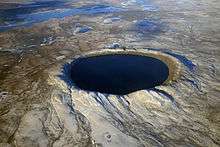H. Jay Melosh
| H. Jay Melosh | |
|---|---|
 | |
| Born |
June 23, 1947 Paterson, New Jersey |
| Citizenship | United States |
| Fields | Geophysics |
| Institutions | Purdue University |
|
Website eaps.purdue.edu/people/faculty-pages | |
H. Jay Melosh (born June 23, 1947) is an American geophysicist, renowned as an expert on impact cratering. He earned a degree in physics from Princeton University and a doctoral degree in physics and geology from Caltech in 1972.[1] Melosh's research interests include impact craters, planetary tectonics, and the physics of earthquakes and landslides. His recent research includes studies of the giant impact origin of the moon, the Chicxulub impact that extinguished the dinosaurs and the ejection of rocks from their parent bodies. He is also active in astrobiological studies that relate chiefly to the exchange of microorganisms between the terrestrial planets (a process known as panspermia, or in his terms transpermia[2]).
Melosh is a member of the American Geophysical Union, Geological Society of America, Meteoritical Society, American Astronomical Society (Division of Planetary Sciences) and the American Association for the Advancement of Science.[1] He is the recipient of the Barringer Medal of the Meteoritical Society for his work on the physics of impact and the G. K. Gilbert Award of the Geological Society of America. He was elected to the National Academy of Sciences in 2003.
Awards & Honors
- Asteroid 8216 Melosh is named in his honor.
- The American Geophysical Union 2008 Harry H. Hess Medal. The medal is for “outstanding achievements in research in the constitution and evolution of Earth and sister planets.”[3]
Publications
- Impact Cratering: A Geologic Process, Oxford University Press, 1989, (ISBN 0-19-510463-3)[4]
External links
References
- 1 2 "Curriculum Vitae" (PDF). Purdue University. Retrieved 24 June 2016.
- ↑ "Swapping Rocks - Exchange of Surface Material Among the Planets". Australian Spaceguard Survey. Retrieved 23 June 2016.
- ↑ "2008 Harry H. Hess Medal Winner". American Geophysical Union. Retrieved 23 June 2016.
- ↑ "Abstract". Harvard-Smithsonian Center for Astrophysics. Retrieved 24 June 2016.

